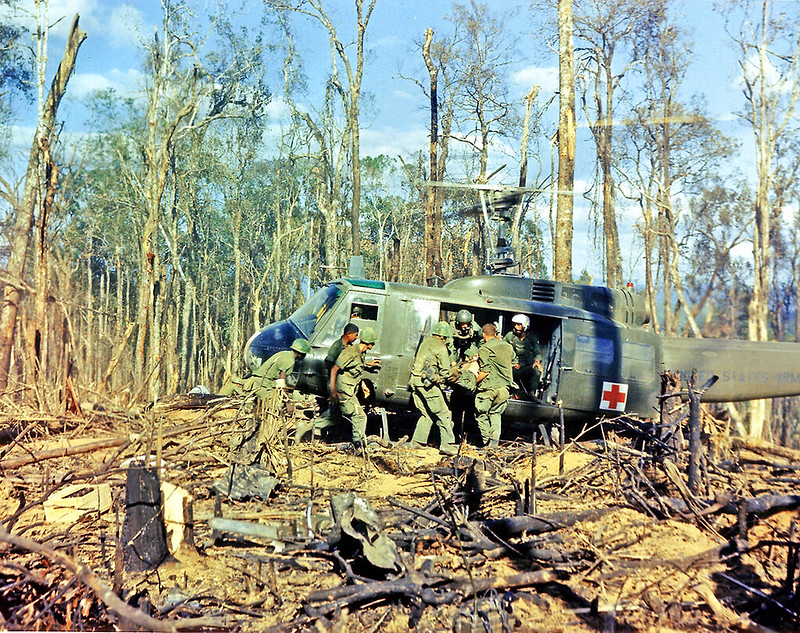Unintended Consequences
 Ninh Binh, Vietnam. Photo by Francisco Anzola. Taken on June 12, 2012. Used by permission via
flickr.
Ninh Binh, Vietnam. Photo by Francisco Anzola. Taken on June 12, 2012. Used by permission via
flickr.
During the early days of World War II, four groups of scientists, two in the U.S. and two in Great Britain, were independently working to identify herbicides that could be used to boost production of food crops by eliminating weeds that depleted the soil or crowded out the desired plants (1). As the war dragged on, one of the men realized the weedkillers might also have military value. He proposed that at high doses the herbicides would kill all plants and not just the unwanted weeds. Both governments embraced this idea and eventually each team of botanists identified the same two chemicals* as the most effective for destroying enemy food crops. Although the war ended before their discovery could be used (2), less than two decades later, the same chemical combination would be tapped for use in Vietnam.
In the 1950s, the U.S. sent military advisors, supplies, and money to South Vietnam in an effort to stabilize the troubled democracy. It wasn’t enough. Soon American Green Berets would arrive. Vietnam’s lush rubber trees, expansive rice paddies, and dense, dark green jungles provided ample cover for the enemy. Ambushes were common and deadly.
In 1961, Operation Ranch Hand, the military campaign to destroy Vietnam’s jungles, was initiated (3). Over the next decade millions of gallons of defoliants were used across Southeast Asia. The chemicals were shipped in 55-gallon black barrels with a different color stripe depending on its contents. The most powerful and widely used combination bore an orange stripe and was nicknamed “Agent Orange.”
 Wounded being evacuated from a jungle decimated by Agent Orange. Near Dak To, Vietnam, November 23, 1967.
Wounded being evacuated from a jungle decimated by Agent Orange. Near Dak To, Vietnam, November 23, 1967.
Photo by: Consolidated
Alfred Batungbacal.
Uploaded to flickr by Manhhai.
Acres and acres of South Vietnam were sprayed with Agent Orange. It destroyed any kind of vegetation and decimated the thick forests that covered much of the country. Although during the war Agent Orange was highly effective in protecting Western soldiers from enemy ambushes, the long-term price would be high.
Early in the 1960s, the manufacturers of Agent Orange discovered that the product being shipped to Vietnam was contaminated with dioxin. Dioxin is a highly toxic chemical that is known to damage the immune, endocrine, and reproductive systems of humans and other animals (4-9). Studies in mice found that many of the effects of dioxin could be passed down to the next generation (10-13). Improvements were seen in the third and fourth generations, but these animals did not completely escape the effects of their ancestor’s exposure.
Agent Orange wasn’t supposed to contain dioxin. It was a by-product of the manufacturing process. Although the problem was identified early on, the solution was time-consuming and expensive and was never implemented. Use of Agent Orange in Southeast Asia continued until 1972 when knowledge of its harmful effects could no longer be ignored (4).
 Kaylon Bruner-Tran, PhD (center) with her long-time research partner, Kevin Osteen, PhD (left)
and Ken Gamble (right), the founder of the Orange Heart Medal Foundation which recognizes American
Vietnam-Era veterans exposed to Agent Orange.
Kaylon Bruner-Tran, PhD (center) with her long-time research partner, Kevin Osteen, PhD (left)
and Ken Gamble (right), the founder of the Orange Heart Medal Foundation which recognizes American
Vietnam-Era veterans exposed to Agent Orange.
Decades later, the path of Agent Orange’s destruction winds through generations. Multiple types of cancer, heart disease, diabetes, dementia, and numerous other conditions are more common in men who served in Vietnam compared to those who didn’t (14) (15). Their children and grandchildren often suffer with birth defects like spina bifida or missing limbs and are at an increased risk of developing leukemia and other diseases (16).
The fate of the people in Vietnam has been far worse. Although the U.S. has spent billions of dollars on remediation efforts, many parts of the country remain contaminated with dioxin and may never be the same. Millions of Vietnamese civilians were exposed during the war, and because of the contamination of the water and land, their exposure didn’t stop when the spraying ended. Serious diseases, stillbirth, and preterm birth are frequently observed (17) (18). Far too many children suffer with one or more severe birth defects. Multiple missing or misshapen limbs, blindness, and mental disability are common (4) (18).
Since the original scientific studies that led to the development of Agent Orange were conducted during World War II,
the U.S. and British governments placed a temporary moratorium on publication of the work. The delay each group faced
in being able to report their findings ultimately led to uncertainty over which team of scientists should receive credit
for the discovery of the chemicals that came to be known as Agent Orange (2). Nearly 80 years later there is no dispute
regarding the unintended consequences of their work. Although I cannot speak for these men, my guess is that if they were
still alive today they would be devastated by
the death and destruction their work produced and would likely be grateful
for the uncertainty
surrounding who among them deserves the credit for it.
Notes:
*2,4-Dichlorophenoxyacetic acid (2,4-D) and 2,4,5-Trichlorophenoxyacetic acid (2,4,5-T) were the herbicides used for Agent Orange. It was unintentionally contaminated with 2,3,7,8-tetrachlorodibenzo-p-dioxin (TCDD or, more commonly, dioxin).
This article was originally published in the Relatable Voice magazine (December, 2022).
References:
(1) Olson K and Cihacek L. (2022) How United States Agricultural Herbicides Became Military and Environmental Chemical Weapons: Historical and Residual Effects. Open Journal of Soil Science,12:2
(2) Troyer, JR (2017) In the beginning: the multiple discovery of the first hormone herbicides Cambridge University Press.
(3) Open Ranch Hand Initiated
(4) Martinez, L. 2020. American Studies, International Relations, Military History, Political History, Political Science, Public Health, Social Sciences, Sociology.
(5) Czarnywojtek A, Jaz K, Ochmańska A, Zgorzalewicz-Stachowiak M, Czarnocka B, Sawicka-Gutaj N, Ziółkowska P, Krela-Kaźmierczak I, Gut P, Florek E, Ruchała M. 2021. The effect of endocrine disruptors on the reproductive system – current knowledge. European Review for Medical Pharmacology Science. 25(15):4930-4940.
(6) Bruner-Tran KL, Gnecco J, Ding T, Glore DR, Pensabene V, Osteen KG. 2017. Exposure to the environmental endocrine disruptor TCDD and human reproductive dysfunction: Translating lessons from murine models. Reproductive Toxicology. 68:59-71.
(7) Kreitinger JM, Beamer CA, Shepherd DM. Environmental Immunology: Lessons Learned from Exposure to a Select Panel of Immunotoxicants. Journal of Immunology 196(8):3217-25.
(8) EPA: Learn about Dioxin
(9) WHO: Dioxins and their effects on human health
(10) Gaspari L, Paris F, Kalfa N, Soyer-Gobillard MO, Sultan C, Hamamah S. 2021 Experimental Evidence of 2,3,7,8-Tetrachlordibenzo-p-Dioxin (TCDD) Transgenerational Effects on Reproductive Health. International Journal of Molecular Science. 23;22(16):9091.
(11) Bruner-Tran KL, Osteen KG. 2011. Developmental TCDD Exposure is Associated with Infertility and Adverse Pregnancy Outcomes across Multiple Generations Reproductive Toxicology 31(3):344-50.
(12) Ding T, McConaha ME, Boyd KL, Osteen KG, Bruner-Tran KL. 2011. Developmental Dioxin Exposure of Either Parent is Associated with an Increased Risk of Preterm Birth in Adult Mice Reproductive Toxicology 31(3):351-358.
(13) Mokshagundam S, Ding T, Rumph JT, Stephens VR, Osteen KG, Bruner-Tran KL. 2020. Developmental TCDD Exposure Enhances the Formula-Associated Risk of Necrotizing Enterocolitis in Neonatal Mice. Birth Defects Research 112(16):1209-1223.
(14) Agent Orange Exposure Doubles Risk of Developing Dementia, Study Finds
(15) Committee to Review the Health Effects in Vietnam Veterans of Exposure to Herbicides (Tenth Biennial Update); Board on the Health of Select Populations; Institute of Medicine; National Academies of Sciences, Engineering, and Medicine. 2016. Veterans and Agent Orange: Update 2014. Washington (DC): National Academies Press (US) PMID: 27099897
(16) Peak, E. 2014. A haunted legacy: The multi-generational effects of Agent Orange. Mountain Xpress.
(17) Vuong TP. 2022. Research on the Relationship between Exposure to Dioxins and Cancer Incidence in Vietnam Toxics 10(7):384.
(18) Ngo AD, Taylor R, Roberts CL, Nguyen TV. 2006. Association between Agent Orange and birth defects: systematic review and meta-analysis. International Journal of Epidemiology. 35(5):1220-30.
Quick Links
| Pages | Other Pages | |
|---|---|---|
| Home | The Agent Orange Trilogy | |
| The RAM Blogs | Edge of Justice | |
| Books | Help | |
| Media | ||
| About Me | ||